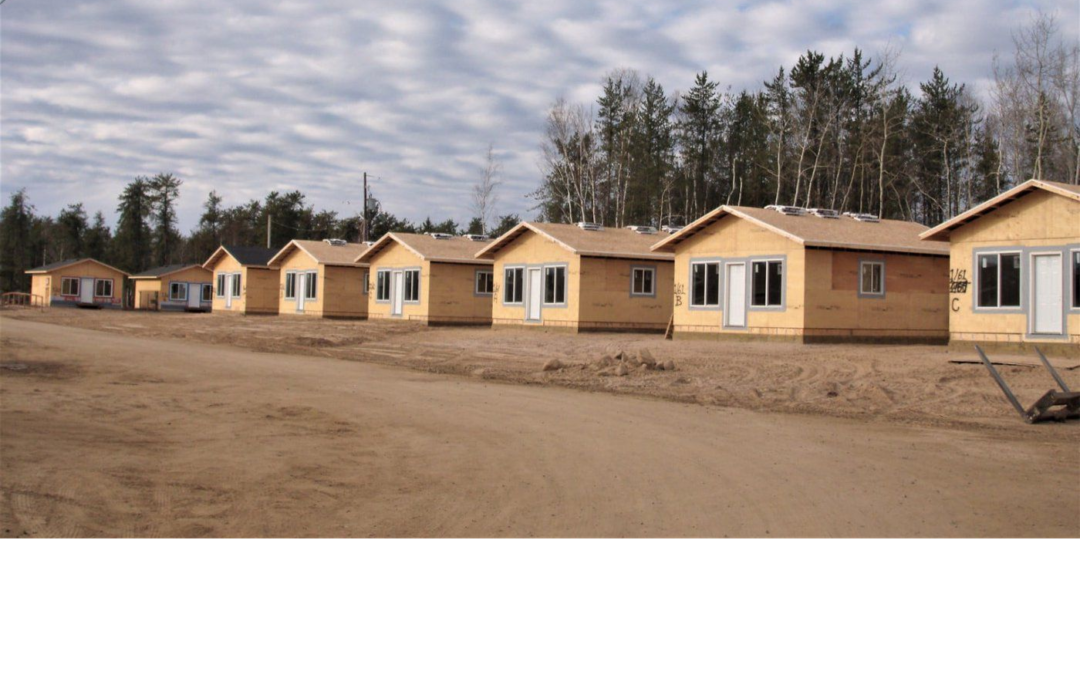Small homes are an ongoing construction project in La Loche. PHOTO BY RAYMOND DAUVIN /Facebook
By: Kimiya Shokoohi Local Journalism Initiative, The StarPhoenix
Despite the small size of its population, the northern Saskatchewan town of La Loche often confronts problems that plague much larger cities.
Panhandlers can be found outside shops in the town of around 2,500 people. Some customers spend too many hours at the local bar. Mental health issues persist for many.
Article contentLeaders in and around the community hope the recent addition of eight more “tiny home” units to an ongoing development can be a small part of helping those who face such struggles.
“It gives people a little more structure in their lives,” said Rebecca Rackow, director of advocacy with the Saskatchewan division of the Canadian Mental Health Association.
“Those determinants of health are also determinants of mental health — the feeling of safety and the feeling of a place to live.”
However Rackow said she’s unsure whether residents of the housing units are getting further supports.
Substance abuse and mental health continue to be a prevailing concern for people in rural northern Saskatchewan.
Most communities have limited access to professional psychologists and counsellors. There are few, if any, extensive programs for mental health and similar assistance in the rural north because low-population communities are often overlooked as high-impact regions.
The pandemic further exacerbated mental health challenges and homelessness.
La Loche was among the communities badly affected by COVID-19. While the outbreak was contained, health-related instabilities are ongoing. In April, a student and a teacher were stabbed at the same high school where a 17-year-old boy shot and killed four people and injured seven others in 2016.
“We have a shortage of professionals overall,” Rackow said, referring to trained psychologists and counsellors in northern rural communities where fewer people live.
“If you look at bang for your buck, you’re looking at resolving more issues in more populated areas,” she said. “It’s not right, because everybody deserves access to services.”
A longtime resident said the housing units previously built are in varying conditions. Some have broken windows and have not been well maintained. Some tenants struggle to keep up with the bills that come with ready-to-move-in homes.
Keith Shewchuk, president of Métis Local 39, said demand far outweighs the housing supply. Leaders in the community say they are inundated with applications for housing. The pandemic exacerbated homelessness.
The ongoing development of housing units is a part of a national homelessness strategy launched in 2019 to support the need of some of Canada’s most vulnerable people; the goal is to reduce chronic homelessness by 50 per cent by 2028.
“We’ve been fortunate to acquire both provincial and federal funding and they have been extremely supportive. We’re just unable to keep up with demand,” La Loche Mayor Georgina Jolibois said.
More staff and further training are needed to continue to apply for funding to help people in need, she added.
During the pandemic, the La Loche Friendship Centre built a homeless shelter for people who may have previously been couch surfing or staying with friends and relatives. Shewchuk, who sits on the board of the centre, said the pandemic revealed a larger issue than rural communities have the resources and capacity to handle.
“We realized we had a lot of homeless people in our community that had nowhere to go,” he said.
Nationally, the Canada Mortgage and Housing Corporation estimates Canada needs about 3.5 million more housing units by 2030 to restore affordability.
The advancement in government-led housing in rural Saskatchewan may well speak to an alternative approach, moving the mandate away from the private sector that in major cities has driven the market beyond affordability for the average resident.
In Saskatchewan, the provincial and federal governments have cost-matched an investment of $449.9 million by the Canada Mortgage and Housing Corporation through the Saskatchewan Bilateral Agreement.
The government-based housing unit projects are part of a federal and provincial 10-year national housing strategy worth more than $82 billion. To date, 388 homes have opened in Saskatchewan at an estimated value of $6.4 million.
While not exactly solving health issues surrounding homelessness in rural Saskatchewan, the government initiative may be an example of affordable restoration to the general housing crisis.
“A lot of the people need to get out of the addiction cycle,” Shewchuk said. “Even the ones that aren’t struggling with addictions.”
